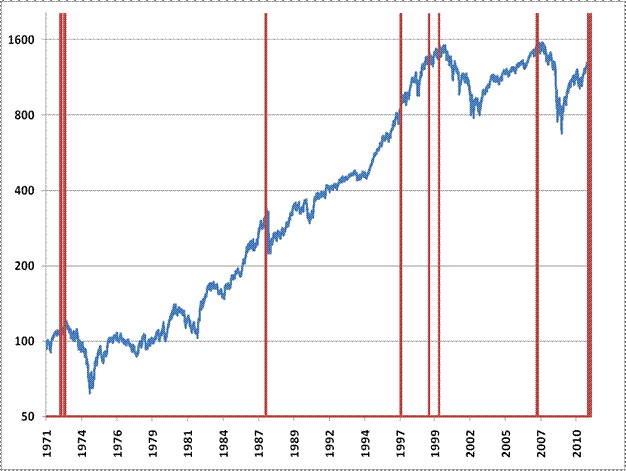by Cullen Roche
John Hussman’s weekly letter has some excellent insights into the unusual market conditions we are currently confronted with. Clearly, the Bernanke Put has exacerbated moves in just about every market. The result is an ever increasing disequilibrium. This, after all, is what the Greenspan/Bernanke Put has been doing to the market for the last 25 years. Rather than allowing markets to be markets, the Fed has felt the need to coddle and “talk up” markets at every chance possible. They see this as some sort of positive contributing force. I see it as a highly destabilizing market force that significantly contributes to the volatility of the business cycle. The market is not the real economy. Therefore, focusing government policy on nominal wealth creation is just another way of putting the cart before the horse.
So, just how extreme are the current conditions? Mr. Hussman notes:
“It’s clear that present conditions are among the most extreme in history. In fact, to capture instances other than today, 1987 and 2007, we have to broaden the criteria. The following are sufficient for purposes of discussion:
1) Overvalued: Shiller P/E over 18 (presently, the multiple is over 24)
2) Overbought: S&P 500 within 1% of its upper Bollinger band on a daily, weekly and monthly resolution (20 periods, upper band 2 standard deviations above the moving average), and S&P 500 at least 20% above its 52-week low.
3) Overbullish: Investors Intelligence bullish sentiment at least 45% and bearish sentiment less than 25% (presently, we have 54.3% bulls and 18.5% bears).
4) Rising yields: Yields on the 10-year Treasury and the Dow 30 Corporate Bond Average above their levels of 6 months earlier.
I should note that while present conditions easily fit into the foregoing criteria, we generally use a somewhat less restrictive criteria to define an “overvalued, overbought, overbullish, rising-yields syndrome in practice, in order to capture a larger number of important but less extreme periods of risk. The foregoing set of conditions isn’t observed often, but the historical instances satisfying these criteria in post-war data are instructive. Here an exhaustive list of them:
August 1972, November-December 1972: The S&P 500 quickly retreated about 5% from its August peak, then advanced again into to its bull market peak near year-end (about 6% above the August peak). The Dow then toppled -12.3% over the next 50 trading days, and collapsed to half its value over the following 22 months.
August 1987: The market advanced about 6% from its initial signal into late August. The S&P 500 then lost a third of its value within 8 weeks.
June 1997: The only mixed outcome, during the strongest segment of the late 1990′s tech bubble. The S&P 500 advanced another 10% over the following 8 weeks, surrendered 4%, followed with a strong advance for several months, surrendered it during the 1998 Asian crisis, and then reasserted the bubble advance. Over a 5-year period, the overvaluation ultimately took its toll, as the the S&P 500 would eventually trade 10% below its June 1997 level by the end of the 2000-2002 bear market. Still, the emergence of the internet, booming capital spending, strong economic growth and job creation, rapidly falling inflation, and dot-com enthusiasm evidently combined to overwhelm the negative short- and intermediate-term implications of this signal.
July 1999: The S&P 500 advanced by 3% over the next two weeks, then declined by about 12% through mid-October, and after a recovery to the March 2000 bull market high, the S&P 500 fell far below its July 1999 level by 2002.
March 2000: The peak of the bubble – the S&P 500 lost 11% over the following three weeks, recovered much of that initial loss by September, and then lost half its value by October 2002.
May/June 2007, July 2007: The S&P 500 gained 1% from the late-May/early-June signal to the July signal, then lost about 10% through August 2007, recovered to a marginal new high of 1565.15 by October (about 1% beyond the August peak), and then lost well over half of its value into the March 2009 low.
February 2011, April 2011: A cluster of signals in the 2-week period between February 8-22 immediately followed by a decline of about 7% over the next 3 weeks. As of Friday, the market has recovered to a marginal new high about 1.5% above the February peak.
So not including the cluster of signals we’ve observed in recent months, we’ve seen 6 clusters of instances in post-war data (we’re taking the 1997, 1999 and 2000 cases as separate events since they were more than a few months apart). Four of them closely preceded the four worst market losses in post-war data, one was quickly followed by a 12% market decline, and one was a false signal over the short- and intermediate-term, yet the S&P 500 was still trading at a lower level 5 years later. The red bars indicate instances of this syndrome since 1970, plotted over the S&P 500 (log-scale).”
You can clearly see that these destabilizing environments became more pronounced during the Greenspan era. This was the beginning of the Fed’s unprecedented direct intervention in markets and their very vocal market prognostications. The Bernanke era is looking no different. In fact, you could even argue that it is worse. Mr. Greenspan was never as explicit about the Fed’s desire to see higher asset prices as the Bernanke Fed has been. And while John Hussman’s work may not turn out to be prescient (though always enlightening) it does shed some light on the evolving role of the Fed and the highly destabilizing factor they play in the markets.

No comments:
Post a Comment